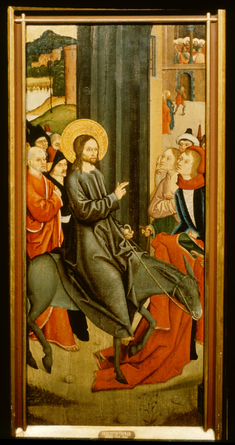Pilate Washing His Hands of Guilt for Christ's Death
(Renaissance Europe )
These four panels (Walters 37.665, 37.666, 37.672, and 37.673) depicting episodes from Christ's Passion were originally part of a "polyptych" or multi-paneled altarpiece commissioned by the Carthusian monastery in Buxheim, Swabia, and completed by 1500. Other panels are in Berlin and Augsburg.
In Walters 37.672, we see Christ's entry into Jerusalem, with the Last Supper tucked into the upper right corner. In "The Arrest of Christ," (Walters 37.666) the emotional intensity of the scene is stressed through crowding and agitated, angular gestures. Strigel was fascinated by detail and shows accurately rendered 15th-century polearms, such as the halberd and pike, in the hands of the peasant mob around Christ. In this piece, we see Christ before the Roman governor Pilate, and in the distance the next event: Christ forced to carry his cross to the place of execution.
The white shapes suspended mysteriously along the tops of two panels are the ends of scrolls held by two prophets who were depicted on panels above these in the complete altarpiece.
Provenance
Provenance (from the French provenir, 'to come from/forth') is the chronology of the ownership, custody, or location of a historical object. Learn more about provenance at the Walters.
Henry Walters, Baltimore, before 1909, by purchase; Walters Art Museum, 1931, by bequest.
Conservation
| Date | Description | Narrative |
|---|---|---|
| 12/3/1976 | Treatment | repaired |
Measurements
framed: 62 3/16 x 28 7/8 x 2 3/4 in. (158 x 73.4 x 7 cm)
Credit Line
Acquired by Henry Walters, before 1909
Location in Museum
Centre Street: Third Floor: 15th-Century Art of Northern Europe
Accession Number
In libraries, galleries, museums, and archives, an accession number is a unique identifier assigned to each object in the collection.
In libraries, galleries, museums, and archives, an accession number is a unique identifier assigned to each object in the collection.
37.665



